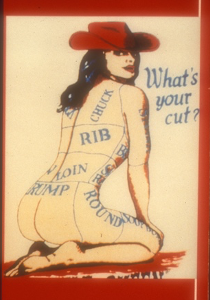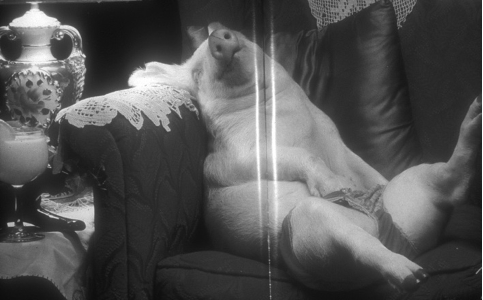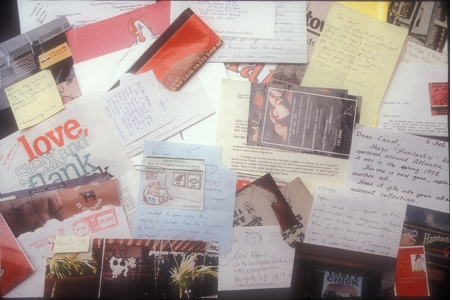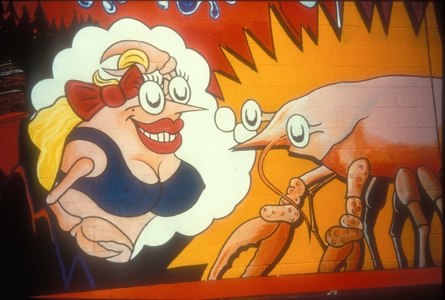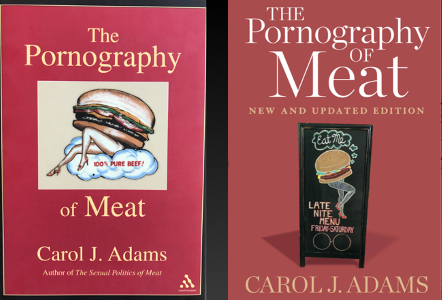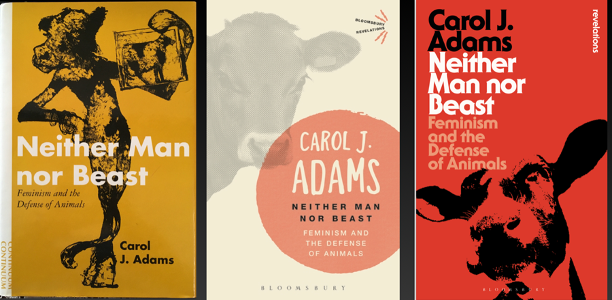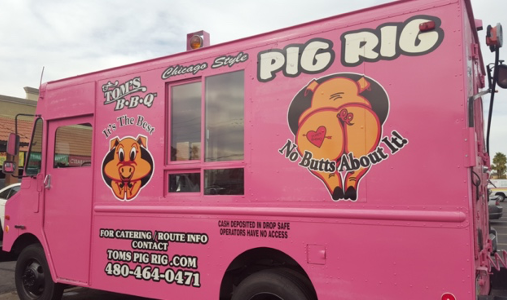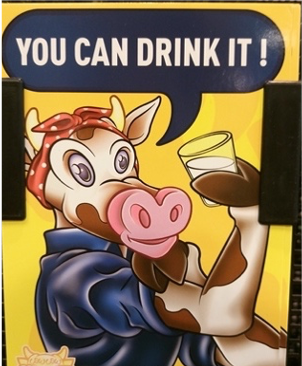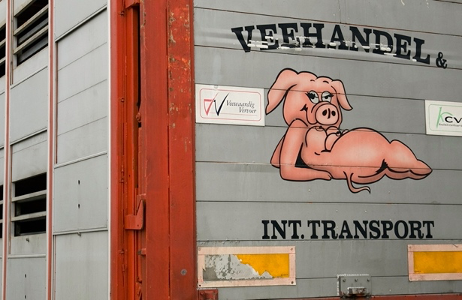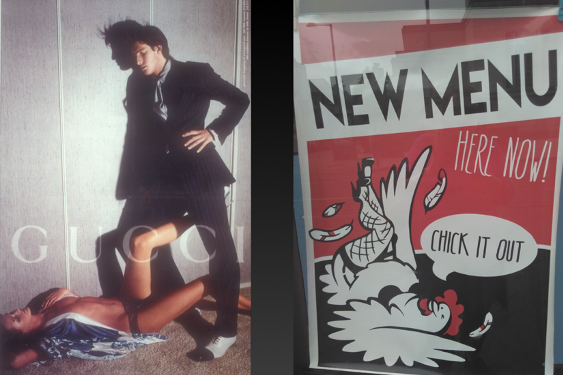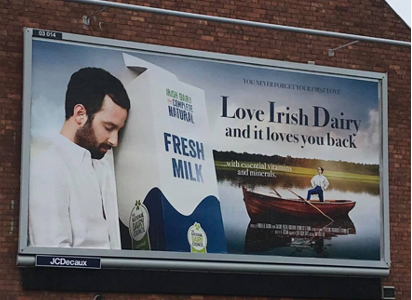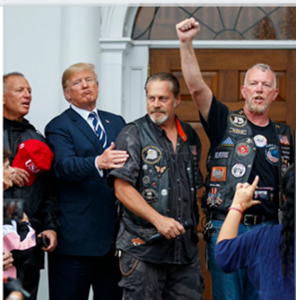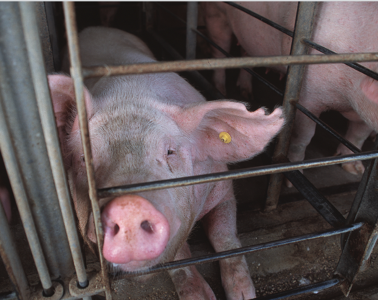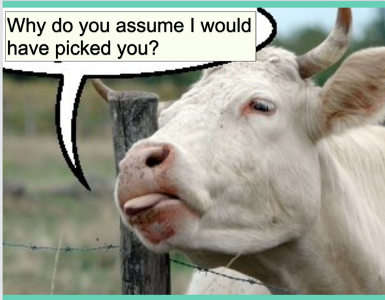Notes from WATERtalks: Feminist Conversations in Religion Series
“The Pornography of Meat: The Misogyny We Don’t Want to See”
with Carol J. Adams
Wednesday, June 16, 2021
Audio recording available here; Video recording available here
Mary E. Hunt, introduction
Good afternoon. Welcome to all of you and a special welcome to our guest Carol J. Adams who will speak today about “The Pornography of Meat: The Misogyny We Don’t Want to See.” Carol, I’m only sorry you are not here in person.
Like all of WATER’s efforts, this WATERtalk is not simply an academic seminar. It is a way to learn in order to bring what we learn to the creation of a more just and equitable world. By studying Carol’s work, we take another step toward deepening our understanding of the relationship between humans and animals, and the ways in which exploitation and injustice continue to flourish despite our best efforts. This is not an easy topic, but it is one that Carol has been working on for decades with global reach and ever-deepening intersectional analysis.
Carol Adams is a valued friend and colleague over nearly five decades since we were at Yale Divinity School and Harvard Divinity School respectively in our youth at a high point of early feminist work in religion. Her work then—from early articles on feminism and vegetarianism to her creative tour of the graves of great women at Mt. Auburn Cemetery–was hints and glimpses of the enormous and influential body of work that she continues to produce year after year, article, theme, and blog after monograph, recipes, and edited collections.
Carol J. Adams is a unique feminist scholar and activist whose work she says “explores the cultural construction of overlapping and interconnected oppressions, as well as the ethics of care.” Her debut book, The Sexual Politics of Meat, celebrated its 30th anniversary in 2020 while a new and updated version of The Pornography of Meat (Bloomsbury Academic) originally published in 2004.
Here is what we at WATER said about it:
“The original edition caused a stir, and this one is sure to generate brave conversations about the reality of sexism and meat. The images are many and relentless. They make the case that the text spells out: ‘the pornography of meat exploits the asymmetrical relationship of gender to normalize animal oppression, simultaneously naturalizing the gender binary and a consumer vision in which farmed animals are imputed to desire their own death and consumption’ (p. 17). Read and heed.”
The book’s promotion reads, “The visual accompaniment and sequel to The Sexual Politics of Meat, it includes 340 images sent from around the world by Adams’s readers, whom she calls ‘grassroots sociologists.’” I can attest that it is a hard read, a book that sears into memory and imagination the images we are bombarded with daily but simply, like the proverbial fish in water, miss.
Her slideshows, long before we dreamed of sharing our screens on Zoom, have mesmerized audiences. Carol is, if I may use the term, “a rock star” especially among young people who see in her work the intersectionality that they seek to analyze and live with integrity.
Carol has written on many topics, including anti-violence, Jane Austen, not to mention Frankenstein. She is also the author of Burger, in Bloomsbury’s Object Lessons Series, and co-author with Virginia Messina of Protest Kitchen: Fight Injustice, Save the Planet, and Fuel Your Resistance One Meal at a Time, and of many other books including Living Among Meat Eaters: The Vegetarians’ Survival Handbook.
Her articles have appeared in the New York Times, the Washington Post, Ms. Magazine, The Christian Century, Tikkun, and Truthdig, among others. She is working on a memoir of her mother based on her essay from the New York Times, “Finding Myself in My Mother’s Calendars” which is something to anticipate.
Such a quasi-clinical introduction of Carol Adams misses so much—her astonishing intellect, her photographic memory, her endless commitments to people, animals, and the planet that began in Forestville, New York where she grew up. Early work on violence against women and constant concern for animal rights beginning with her childhood pony Jimmy run through to the present when she took vegan food to people in voting lines in Texas where she lives with her partner, Bruce Buchanan. No one was surprised by her generous choice to have her recent 70th birthday party be a benefit for an LGBTQIA-run animal sanctuary named VINE in Vermont which will now build a barn that will be named in her honor.
I would be remiss to leave out her cooking prowess, her delight in her adult sons, now also in her daughter-in-law and a little feminist granddaughter. The list is endless, but right at the top, as I have learned, is Carol’s deep faithfulness to her friends through thick and thin. The Rev. Dr. Marie Fortune, founding director of the FaithTrust Institute which seeks to eradicate sexual and domestic violence, and I are the happy friends to whom the volume we will discuss today is dedicated for “forty-five plus years of action, engagement, and remembering.” Ours is the only non-pornographic picture in the book! Thanks, Carol, and a huge welcome.
Carol Adams
First book, The Sexual Politics of Meat, was published 31 years ago
- The book included two main images illustrating its point: a woman with meat-cut markings drawn on her body appeared on the cover and “Ursula Hamdress,” a pig lounging in lingerie.
-
- These images illustrate overlapping oppressions of women and animals, a major theme of the book.
- This set something into motion
- After The Sexual Politics of Meat was published, I received mail from readers around the world, who sent examples and photographs → I call them “grassroots sociologists”
- When finished writing The Sexual Politics of Meat, thought, “Well, that’s done! Now what will I work on?”
- But readers, through mail, showed how much these images reproduce and spread
- Grassroot sociologists recognized that how we look at other beings is influenced by oppressive attitudes.
-
- Whose idea was it to represent something good to eat by replicating the male gaze? [“female” lobster with breasts being ogled by a “male” lobster to sell Cajun food]
- With the sexual politics of meat, we are trained to look at objects, and to desire to consume those objects. Even though those objects are, or were, living beings.
- Some of the images in the book are the same, some are new, but the more things changed the more things stayed the same
- a 1980s mural in Manhattan and a 2019 chalk-drawn sign, both of hamburgers with fish-net stocking legs (which became the cover images for the two different editions of The Pornography of Meat)
-
- I call the 2019 image chalk misogyny because it’s a spontaneous image reflecting a culture’s dismissal of women’s autonomy. In other words, we don’t have to look only to large meat, dairy, and dead fish companies to find these kinds of exploitative misogynistic messages.
- Studying visual culture to understand why representation was doing the work of oppression for a patriarchal racist culture
- Why are some art motifs chosen, especially in advertising?
- “Ursula Hamdress” based on Titian’s Venus – already in the cultural context
- Different parodies of Botticelli’s Venus, become the Greek Moothology udderless cow
- The cow is depicted with no breasts/udders while advertising yogurt made from the milk of the udders that are hidden because of its “discrete” pose
Neither Man nor Beast: my second book explored issues around feminism and the defense of animals
-
- Started including the work of feminist artists in my books; Susan Kae Grant, an artist whose work is included in the book, suggested making a slide show with the images from the book
- Went to campuses to share this slideshow, and some of the publicity posters used to publicize the book toed the line between critiquing and participating in it
The slideshow then became a book in 2004, the first version of The Pornography of Meat
- Kept hearing from feminist artists, like Susan Kae Grant, and collecting art that exhibits/protests
- “Olivia Said No,” a girl refuses to drink cow’s milk as a protest to drinking from another animal
- “Chicken Bitch and Bunny” by Nancy Hild, protesting the use of those words as pejoratives
- “My body is mine” graffitied on the wall of a slaughterhouse
- Walking art exhibition of/protest with Suzy Gonzalez’s artwork at a campus presentation
- Artists themselves responded to recorded documentation of oppression, like photojournalist Jo-Anne McArthur’s powerful series of images of a veal calf being removed from their mother
- Led to the art piece “Veal. Calf. Wheelbarrow” by Janell O Rourke, using words used to describe veal when selling the dead animals as meat.
- Collected these works into a book: The Art of the animal: 14 artists on the sexual politics of meat
- But things haven’t really changed over 40 years
- Still the same images in advertising of feminized pigs to sell BBQ
- because the context of multiple oppressions hasn’t changed, though we are more aware of them
- Michael Harris, in a brilliant book, Colored Pictures: Race and Visual Representation, discussing race and representation notes that representations:
- Operate within patriarchal structures
- White male perspective as universal
- Appropriation of female bodies is common
- This describes the functioning of the sexual politics of meat and the pornography of meat
- g. the fetishism of pinkness, representing femininity and whiteness
- Also, the pinkness associated with breast cancer campaigns: the infantilization of white middle-class women who were the targeted consumers in many of the arrangements made with established “pinking”
- Leading to the outrageous Hutches for Hope: pinked the hutches for a veal calf, who are taken from their mothers
- Not to mention it’s by a plastics manufacturer and plastics are linked to cancer
- “Every drop of cow’s milk contains a slice of veal”
- Cows must be continually made pregnant in order to be “productive”
- Cows try to stop the taking away of their calves when they can
- Cows are called derogatory names and treated brutally for trying to reunite with their calves
- We are brainwashed to believe the cow’s relationship is with us, but it isn’t
-
- The cow’s relationship is with the calf, violently separated from the mother
- Cows are absent referents in our use of their lactation material for humans
- The calf is a side-product to the real product cows are used for: milk/their lactation product
The absent referent
- Animals are the absent referent in the consumption of meat, dairy, and eggs
- They disappear as individuals who desire to live and are instead killed and renamed
- Propagandized, brainwashed to think cows want to give up their milk
- Cattle Queen asking “What’s your cut,” the animal is the absent referent
- But with “Ursula,” sexualized women are the absent referent, as well, taking the image of a scantily clad woman and replacing her with a pig
- Cows, pigs, animals used for meat, are depicted as speaking to us, implying that the only desire animals are imputed to have is the desire to be consumed by humans, “Come upstairs and eat me”
-
- To distract you from the beings suffering inside the truck as they are taken to be killed
Women and animals become overlapping absent referents
- Women become animalized; animals become sexualized
- There is also the reinforcement of a male-dominant heterosexuality:
- When a woman is in an image of dominance, the man can be shown as present, but when the subject is a feminized animal, the man is removed so as not to risk implying bestiality
- Male heterosexual assumptions about sexuality are also imposed onto animals, the superiority and strength of the male — sexual violence myths projected onto animals
- She deserved it — She’s a bitch from hell
- She like it — She needs us to take her milk; only happy hens lay eggs
- Women are weaker and need protection — Animals are safer confined
- Virginal whiteness
- Hot dog truck, bus stop advertising
- And white men being associated with the purity of the lactation material of other females: white man, white milk
-
- No cow depicted in the ad, shown in a pastoral landscape at odds with the climate effects and pollution of cow farming
The intersection of race, gender, species is always happening
- Women of color equated with/depicted as wild animals, shown wearing animal print
- Our job is to ask any image, “what is going on here?”
The sexual politics of meat gets new images from the right-wing
- Trump handing out burgers to football players: idea that beefy, muscular men need meat
- Patch on jacket: “This is America. We eat meat. We drink beer and we speak f***in’ English.”
- Symbols of white patriarchal supremacy
- Capitalizing on ideas about meat and milk
- Claiming threats to meat, proud of red-meat-eating, “They’ll take away our meat”
- Fetishizing of milk by neo-nazis: milk as a symbol of racial purity
- White descendants of Northern Europeans are some of the only people who can digest milk: “Secure the existence of lactose tolerant people”
- “Eat beef, the west wasn’t won on salad”
- A myth, of course, and ignores the violence and genocide used to “win” the west
- Western cultures co-constructed meat-eating, drinking mammalian milk, masculinity, nationhood, and white supremacy
- With these developments and expanding understanding, a new edition of The Pornography of Meat was needed with more than 300 images
- The images aren’t about advertisements per se, but how advertisements and other representations illustrate prevailing attitudes:
- Again, patriarchal structures, white male perspective as universal and appropriate of female bodies
Law & Order: SVU, “The Beef Episode,” April 2010. https://www.imdb.com/title/tt1632053/
- Has done this slideshow over and over at college campuses, got noticed and was co-opted for their episode
- “Rear entry pose”
- To discover the murderer, detectives must answer, “Why was a murder victim obsessed with women’s butts?”
- The Law & Order team go to a book signing, where lo and behold, a woman is seen showing slides and saying, “Our society views women and animals pretty much the same… as cuts of meat.” She clicks and moves to the next slide and says “Meat eating and the patriarchal world go hand in hand…We can’t stop the objectification of women until we stop eating our four-legged and winged brothers and sisters.”
- The speaker needed an image for the cover of her book, and the “rear entry position” was seen as perfect.
- Law & Order recognizes the almost uncanny persistence of these images of women’s butts and sexualization of meat
- The Sexual Politics of Meat Slide Show was made into a fictional version for the show for the sake of their plot
Through the sexual politics of meat and the pornography of meat, you are committing discursive violence which allows for a material form of violence
- Don’t just look with resistance, but recognize that images can’t be unanchored from their referent
- Refuse to consume the images on their own terms
- Refuse to consume that which exists because of real violence
- Refuse to be an accomplice:
- Simone Weil: “Don’t lie, don’t keep your eyes shut.”
- Transformation through caring, bringing one’s attention to others
- Feminist Vegan Ethics of Care
- Simone Weil: “All our neighbor requires of us is to ask, ‘What are you going through?’ and be willing to listen to the answer.”
- Acknowledging animals are also our neighbors, and listening to them as another subject, not an object, seeing someone and not something
Q&A Discussion
Question: What movement has happened over the last forty years in terms of progress and regression of vegan/vegetarian causes/consumption?
- Some things have improved, but the challenge of engaging progressives around this issue remains. Sometimes they frame the questions as either/or—either we work for human rights and against authoritarianism or we care about animals.
- But it isn’t an “either/or” dilemma.
- Wanted to title Protest Kitchen as The Anti-Trump Diet (was turned down since “he won’t be here for long”). Protest Kitchen was written explicitly for progressives to see the link between veganism and the issues they are concerned about
- Nonvegan progressives are concerned for food justice, but take up more climate and food space than those in the global South
- recognize that the “democratic story” we tell ourselves covertly assumes meat- and egg-eating and milk-drinking as individual “rights” and links it with “democracy.”
- Yet, the US became meat-centric by breaking treaties and seizing land from indigenous people to get more land to farm cattle; cattle were part of both the means and the ends of settler colonialism
- Eating eggs from chickens and lactation products from cows or switched to fish because believe that it’s better for the environment
- Food justice is an issue which veganism is addressing
- Concerned with climate change but still eating animals when animal agriculture is heavily contributing to the climate apocalypse, from the methane from cows farting to the use of water, fuel, and grain in the production of animal flesh.
- Being a vegan/vegetarian doesn’t keep you from engaging in the world
- Food justice is an issue which veganism is addressing
- Nonvegans think that change is hard, but not changing is even harder they just haven’t realized it yet (point of Living Among Meat Eaters).
- The more veganism is privatized, the harder it is to get the message across
- Vegan chefs have moved vegan eating and culinary arts to a whole new level
- People worried about missing the taste of meat or cheese
- There are other great tastes: can be reproduced but also can find other good tastes
- People worried about missing the taste of meat or cheese
- Many more food alternatives, milk alternatives, etc. than there were
- The next generations are not having these arguments in their heads—they get it that being progressive and being vegan are intimately connected.
Comment: This makes it clear that it’s not incidental that leading activists and speakers for veganism are women
Question: More about the Law & Order: SVU episode?
- Just wish they had gone ahead and called the book in the episode “The Sexual Politics of Meat”
- Obvious that someone had seen the slideshow
- It seems they wanted to use undercover footage from a slaughterhouse, and but because it was SVU and not the regular Law and Order, they needed some sort of sexual aspect to the plot, and the slideshow is used in this way, so it was rather gratuitous
Question: Is there a banning of your books in schools? Waiting for TX legislature to ban it.
-
- We’ll have a party when that happens.
- When book first came out, there was a movement to ban it at an Oklahoma library
- Canada passed a pornography law, and it was being misinterpreted, and the book was stopped at the border because thought to be pornographic because of the cover
- Republican commentators loved to hate it
- Rush Limbaugh loudly denounced it for a whole summer
- He tried to stop speaking events, wrote to campuses to encourage people to protest it
(Thankfully, Carol doesn’t suffer too many trolls.)
Question: Image of Ursula Hamdress looks like someone leaning back in ecstasy after producing a clitoral masturbatory orgasm
- Original image taken from Titian’s Venus with her hand near her crotch is also debated if being modest/covering herself or if she’s enjoying herself
- Was in “PlayBoar,” joke magazine parodied from Playboy
- Reinforces the idea of female sexuality being something men possess, rather than clitoral empowerment/personal pleasure
- Heterosexual norms imposed on animals, and ignored diversity among animals because don’t want diversity in human beings
- Recognizing the power of the erotic for animals
Question: There are criticisms of vegetarianism and veganism being anti-Indigenous/a specific kind of “white veganism,” and advocating instead for regenerative farming. What are your thoughts on these critiques?
- There are indigenous vegan writers, like Canadian Indigenous writer Margaret Robinson
- Veganism isn’t white just because there are white celebrities who are vegan and receive so much publicity
- Remember that the assumption that we need animal protein is a racist idea to begin with, ignoring the worldwide tradition of plant protein and the inability to digest mammalian milk among the majority of the world
- Bryant Terry researching and exploring foods of the African diaspora
- Roxanne Dunbar-Ortiz: most Native nations were vegetarian
- Whites benefited from the myth that Native Americans were mainly hunters because it meant they didn’t have a homeland and could be moved around without disrupting their lives
- But really, many lived in cities
- How have Whites perpetuated a stereotyped Native relationship to animals to justify how Whites interact with animals
- “I thank the animal for its provision like Native Americans do” but how do you know that animal would have picked you?
- Looking at the image of sacrifice of animals in the Christian context
Questions: When you think about violence against women and children, indeed violence against people of color and those who are immigrants, are there new images that you see emerging for your study? I remember some of the early whiskey ads and the woman’s body carved up like meat, but are there new ones that the detention camps at the border conjure up? The crates and pens for children rather than animals are not an exaggeration.
I was thinking of the animal sanctuary you and Marie and I visited outside of San Antonio a few years ago which felt to me like the asylums for those with mental health issues and then I thought about immigrant children separated from their parents who will need help all of their lives to get over such trauma. Any thoughts?
- No images put together yet, but Carol thinks of the infamous Abu Ghraib prison image of the man on the stool: that animalization is the common theme
- Animalization of these children, as already animalized immigrants
- Brown Tide Rising – difference in the description of White women “giving birth” versus Mexican women “dropping their babies,” like an animalistic function
- Before Trump, were already animalizing immigrants and undocumented people
- And they became the workers at dangerous slaughterhouses since they have no rights to protect them and can’t speak out against cruelties against animals or else get reported
- Trump administration would turn a blind eye to workers in slaughterhouses because they need the workers until they start unionizing and are no longer serving the interests of the owners, and then there were INS raids.
- Already a disconnect between immigrants wanting to become citizens and fleeing their home countries because of the climate change effects that we are causing and the increased violence from destabilization we (the US) caused in the 80s and 90s
Comment: Now I’ll never be able to not see this kind of advertising, seeing it everywhere
- Don’t just look! Take a picture and send it to me!
- We also don’t see how these images are still reproducing of pink, feminine animal who “wants you” and wants to provide herself for you
- We think of feminism as advancing, but these images are still here
Question: I was struck many times in your book, and in the short video that you shared, by how creative people are, how clever if pernicious, how unapologetically racist and sexist they are. I know people like that. It indicates that they give a lot of thought to these things as we do. Is there a way to infiltrate that advertising so as to begin to build alliances and get people involved who are against the continual use of these images?
- Not always sure how to connect this work to different fields also affected
- Fashion grad students who ask how to create/participate in fashion that works against this sexualization. Suggestion: stop using pink.
Comment: Huge fan of Law & Order: SVU since Marisa Hargitay has her own foundation supporting women victims of domestic violence, using money from the show to fund it
- That might be true, but Law & Order: SVU itself is problematic in the depictions of violence against women
- When is something reified or not? Is it reification or resistance?
- Same question of when Sexual Politics of Meat was stopped at the Canadian border because of its supposed pornographic content, it asks the question of if it’s resisting the culture and pointing out the problems, or just perpetuating it by spreading the images?
- A fine line between the two
- When something is presented in media, how do you show it in the light of critique?
- Sexual Politics of Meat needed a cover image to explain the contents of the book (and it became an iconic part of it)
- I followed the advice that when you reproduce an image like that, you surround it with text and make it small to disempower it
- Young feminists will send in artwork inspired by The Sexual Politics of Meat, and I feel that fine line between reproducing the harmful images and critiquing it and expressing outrage against it. The key, again, is how it is framed. It requires interpretation.
- But showing these images full-page in the new edition of The Pornography of Meat, that were originally on billboards and the sides of buildings, emphasizes how assaultive they are as they are analyzed
- Show the image as well as the response to it – the resistance
- Final chapter in Pornography of Meat, “Resistance” features work by feminist artists who respond with their own images
Questions: I found the onslaught of images in The Pornography of Meat relentless. What is the trade-off between people becoming inured to it all after a while and pointing out the obvious for those with eyes to see? I know what and why you do what you do, but I had the feeling several times that I wanted it over. I concluded that the only way it will end is if I help to end it so you made your point. It is sort of like people coming out and being told they flaunt their sexuality when it is simply being honest; then the domestication of being gay into monogamous marriages contains it. Is there a parallel here with meat? Seems these huge pernicious, noxious powers always find a way to best us.
- As long as we live in a patriarchal world, it’s too easy to co-opt women’s oppression to create images for animals’ oppression because of the overlap of oppression
- Control of female reproductivity of both human women and female animals
- The collection of bull semen is big business: the descriptions are about strength and aggression when, really, they need docile bulls for collecting it
- The description is for men, not bulls
- Bestiality laws have to create an exception for farmers because what they’re doing in taking the semen and impregnating females could fit the definition of most US bestiality laws
-
- Bull is the substitute for the powerful man and the cow is the submissive woman
- Ritualistic story for the sake of agriculture
Question/Comment: The complications of overcoming the gender binary are what I saw as the newest part of your thinking in this book. Would you say more about that? I was reminded of a very popular restaurant in DuPont Circle in Washington DC, Ruth’s Chris Steak House, a chain that you mention. It is renowned in DC for being gay-friendly, a place where gay men are well fed and treat well. How does that exaggerated masculinity play for men who are sometimes stereotyped as effeminate? How does masculinity become manipulated?
- It is all part of the sexual politics of meat; assumptions about masculinity and meat-eating.
- Remasculinization is a continual project of our culture (after Vietnam, after 9/11, during Trump’s tenure as President), and is a message sent to individual men (I discuss this in chapters 2 and 3 of The Pornography of Meat).
- The assumption of the prejudices inherent to the sexual politics of meat is that the only men who are vegans/vegetarians are gay men (goes back for decades)
- abjects both vegans and gay men
- Through these mutually enforcing cultural structures, men’s role as consumer is delineated: to avoid being abjected and feminized, eat flesh and drink cow’s milk daily.
- From The Pornography of Meat:
- Meat-eating functions as a marker that legitimates the gender binary system. And the gender binary system uses the sexual politics of meat to define who men should be: “real men,” not “sissies,” not “effeminate,” no salad eating unless it is with your hands. (p. 45)
- That a steak house has figured out how to attract customers in the specific location of an urban city that both reinforces assumptions about men eating meat while not being homophobic is not a surprise.
Question: Current projects you’re working on?
- Updating anthology Ecofeminism: Feminist Intersections with Other Animals and the Earth (2013)
- New section explores both our climate crisis and the climate of reception for ecofeminist ideas and actions.
- Pedaling Resistance: anthology on vegan cycling – hasn’t been written on, cross-country bike races that pass by intensive farming lands and make racers aware of these practices
- Anthology against effective altruism – how it’s been used in the animal movement to disrupt funding to sanctuaries and to justify a rationalistic philosophical approach to funding.
- Book based on NYT essay on reading Emma while caring for mother with Alzheimer’s
- Book based on NYT essay “Finding Myself in My Mother’s Calendars”
- Writing about a rape attack on my grandmother: how that influenced how she raised her two daughters, and how that in turn influenced how her daughter raised me, called “The Birth of Feminism”
Mary E. Hunt, closing
Many thanks to Carol Adams for conversation on The Pornography of Meat. Thanks all for joining. We wish you safe and healthy days ahead and good vegan cooking.
Writings by Carol Adams:
A list of all of Carol Adams’s books can be found on her website here: https://caroljadams.com/books
Among them are:
- The Pornography of Meat (2020)
- “Finding Myself in My Mother’s Calendars” https://www.nytimes.com/2019/08/17/opinion/sunday/my-mothers-calendar-memory.html
- “Jane Austen’s Guide to Alzheimer’s”https://www.nytimes.com/2015/12/20/opinion/jane-austens-guide-to-alzheimers.html
Examples of the sexual politics of meat: https://caroljadams.com/examples-of-spom
Readings/authors referred to by Carol Adams:
- Margaret Robinson: Canadian Indigenous Vegan writer https://www.dal.ca/faculty/arts/sociology-social-anthropology/faculty-staff/our-faculty/margaret-robinson.html
- Bryant Terry: African-American vegan chef, food justice activist, and collector of Afro-diasporic food traditions. https://www.bryant-terry.com
- Rozanne Dunbar-Ortiz: historian and activist active in the international Indigenous movement for more than four decades https://www.penguinrandomhouse.com/books/237686/an-indigenous-peoples-history-of-the-united-states-by-roxanne-dunbar-ortiz/
- Brown Tide Rising: Metaphors of Latinos in Contemporary American Public Discourse by Otto Santa Ana: https://utpress.utexas.edu/books/sanbro
- Michael Harris: Colored Pictures: Race and Visual Representation https://books.google.com/books/about/Colored_Pictures.html?id=tNbq3-vuIPkC

